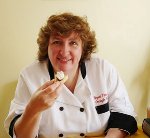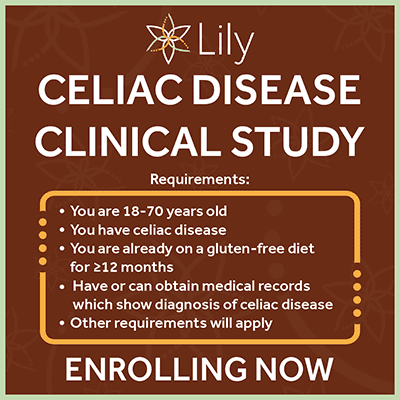02/02/2017
COLUMNS
HEALTH/WELLNESS
Spit: The Treatment for Celiac Disease?
FOOD/LIFESTYLE
CEO Alice Bast Wins
Trailblazer Award
Lemongrass Chicken
Noodle Soup
How Have You Adapted
to the Gluten-Free Diet?
NEWS/UPDATES
Note from Alice: Staving Off the Gluten-Free Winter Blues
 The blahs of wintertime can take hold – and fast. There’s evidence to suggest the lack of sunlight in winter disrupts our internal clocks, drops the body’s serotonin levels and may intensify feelings of melancholy.
The blahs of wintertime can take hold – and fast. There’s evidence to suggest the lack of sunlight in winter disrupts our internal clocks, drops the body’s serotonin levels and may intensify feelings of melancholy.
It’s important to appreciate that the connection between depression and celiac disease is well established; the condition can be both a symptom and a result of celiac disease. But while there is no surefire way to prevent depression, there are strategies to keep the doldrums at bay.
1. Vigilantly adhere to the gluten-free diet.
When we’re feeling down or left out, it is easy to be tempted to take food risks. A 2011 study, however, found that female celiac patients who kept to a strict gluten-free diet reported better overall mental health and a lower level of stress than those who had less diet compliance. Continue reading.
Cooking with Oonagh
Tenderloin, Veal, Chicken or Pork la Crème
.jpg)
I’ve never cared to eat out on Valentine’s Day. The restaurants are crowded and, often, the meal is overpriced and not very good. This recipe is fabulous with beef tenderloin or fillet steak, but tenderloin easily costs $20 per pound, so I’ve made it with Angus petite sirloin when it’s on sale, as well as chicken breast and pork tenderloin. As you all know, you can’t even rely on any beef steak to be tender—some from the same packet are meltingly tender and others really chewy. With pork tenderloin or chicken, this is really affordable for a dinner party. The sauce can be made the night before. I normally don’t serve this with any other vegetable with this apart from some tiny potatoes, which can be cooked and ready to reheat in boiling water the night before as well.
Crème Brûlée
.jpg)
This version of the classic recipe came from my friend Cheryl Emerson, the Pastry Chef Instructor at Milford High School. This makes 4 not-so-indulgent portions or 2 very indulgent portions. There is a difference in texture between using whole eggs and egg yolks, which make a far richer custard. DO NOT overcook, as the custard changes from silky smooth to firmer and grainier the longer you cook them. There is no need to cook custard in a double boiler (saucepan) first and then cook in oven. I have tried making them with coconut milk, but it is not as wonderful. Without caramel, these are still wonderful. Even better, it’s a dessert best made a day in advance.
About Chef Oonagh Williams
 Chef Oonagh Williams has a culinary arts degree, celiac disease and other food allergies. She spends her time speaking and writing nationally on food for gluten-free and other food allergy diets, as well as offering cooking classes, dinner parties and one-on-one help. Locally, she teaches healthier food cooking classes for everyone, as most real food is naturally gluten-free and free of many other allergens.
Chef Oonagh Williams has a culinary arts degree, celiac disease and other food allergies. She spends her time speaking and writing nationally on food for gluten-free and other food allergy diets, as well as offering cooking classes, dinner parties and one-on-one help. Locally, she teaches healthier food cooking classes for everyone, as most real food is naturally gluten-free and free of many other allergens.
Chef Oonagh will be teaching a six-hour gluten-free baking class at a Culinary Arts College in Maine in March, plus various cooking classes in Boston, MA in the upcoming months. Chef Oonagh is speaking and giving a food demo at the Boston Celiac Symposium on Saturday, April 1; other speakers include top doctors from Beth Israel, Mass General and Harvard Medical School.
Buy her Delicious Gluten Free Cooking e-book, with over 200 pages and full-color photos, for only $20. Like her at Gluten Free Cooking with Oonagh on Facebook, where she posts recipes, links to her New Hampshire ABC appearances and products she’s found and tasted. Connect with her on Skype for help in following a food allergy or gluten-free diet.
Getting Out of the “Same Old Food” Slump
By Beyond Celiac volunteer Julie Terrana of Best Whole Self
It is not uncommon to feel that you have fallen into a food rut when eating gluten-free. We are comfortable eating the foods we know are safe, taste good and are easy to prepare. However, this leads to having the same meals over and over again until we get bored with what we are eating.
I know this vicious cycle all too well, so I have decided to share a few of my favorite recipes and tips to help you break out of your redundant food slump.
Try Different Types of Ethnic Food
Cooking ethnic food can be intimidating. Some recipes require ingredients we have never heard of, or techniques can be required that are unfamiliar to us. Below are 3 of my favorite recipes that have taken me out of my cooking comfort zone, are not challenging, and are absolutely delicious.
Create New Variations of Your Favorite Recipes
There are two things I love in life — pasta and chocolate. However, consuming these in copious amounts can be detrimental to my health in many ways. I decided to create recipes that taste like my favorite dishes, but have a healthy twist to them. The key to a healthy swap is to make it just as easy as the original recipe without compromising the flavor. That is exactly what I had aimed to accomplish with my Avocado Chocolate Mousse and Spaghetti Squash Puttanesca — and it worked!
Treat Yourself
Valentine’s Day is right around the corner, so it is only fitting that you give yourself some self-love by indulging (moderately) in tasty gluten-free treats. These are my favorite for delicious cupcakes, cookies, and pies that can be picked up in-store or delivered right to your home.
About Julie Terrana of Best Whole Self
 Julie is a Certified Health and Wellness Coach in Philadelphia. She has been a volunteer for Beyond Celiac since 2013. Living with Crohn’s Disease, Julie has had a goal to reach remission since 2009. Despite trying numerous medications, she continued experiencing severe flares that led her to being hospitalized and eventually having surgery. In the summer of 2013, Julie went gluten-free and it changed her life. She has since experienced fewer flares and was able to run a half marathon in November 2013. Julie’s journey adjusting to a gluten-free diet has led her to develop a passion for helping others adapt to a similar lifestyle changes. She shows her clients that living with dietary restrictions does not have to be difficult and teaches them to navigate the obstacles of gluten-free living with ease and grace. Physical and emotional health are the main focal points in working with clients, which has led Julie to committing to her motto, “It is not about being skinny. It’s about being your best whole self.”
Julie is a Certified Health and Wellness Coach in Philadelphia. She has been a volunteer for Beyond Celiac since 2013. Living with Crohn’s Disease, Julie has had a goal to reach remission since 2009. Despite trying numerous medications, she continued experiencing severe flares that led her to being hospitalized and eventually having surgery. In the summer of 2013, Julie went gluten-free and it changed her life. She has since experienced fewer flares and was able to run a half marathon in November 2013. Julie’s journey adjusting to a gluten-free diet has led her to develop a passion for helping others adapt to a similar lifestyle changes. She shows her clients that living with dietary restrictions does not have to be difficult and teaches them to navigate the obstacles of gluten-free living with ease and grace. Physical and emotional health are the main focal points in working with clients, which has led Julie to committing to her motto, “It is not about being skinny. It’s about being your best whole self.”
Back to top.
GEMM Babies Continue to Shine
By Amy Ratner, Beyond Celiac Medical and Science News Analyst

A study of babies designed to determine how celiac disease develops and ways to prevent it continues to make progress.
Researchers conducting the Celiac Disease Genomic Environmental Microbiome and Metabolic Study (CDGEMM) reported that they have enrolled 90 children in 25 states in the United States, as well as 75 children in Italy.
They’ve collected 400 stool samples, which are being used to track the development of the gut microbiome, the bacteria that live normally in the gut, by watching how microbial communities evolve over time.
“We hope to identify a distinct microbial pattern that will allow us to predict who will develop celiac disease before it happens so we know how to prevent it,” said researchers at the Center for Celiac Research at Massachusetts General Hospital, MassGeneral Hospital for Children and the Celiac Program at Harvard Medical School. Continue reading.
Healthcare Costs of Celiac Disease Pinch the Pocket

By Amy Ratner, Beyond Celiac Medical and Science News Analyst
Gluten-free food isn’t the only thing that costs celiac disease patients more, according to a recent study that looked at healthcare expenses associated with the disease.
Researchers found those diagnosed with celiac disease had healthcare costs between two and nearly four times that of healthy controls, depending on whether their celiac disease was completely or partially controlled.
“This study highlights the additional healthcare resource use and costs associated with celiac disease on top of gluten-free-diet costs,” said Stefano Guandalini, M.D., founder and medical director of the University of Chicago Celiac Disease Center. “It focuses on the costs borne by insurers, as well as the medical burden of celiac disease for patients.”
The economic burden of celiac disease, as well as the fact that patients continue to have symptoms even if they follow a gluten-free diet, point out the need for better treatments, researchers noted.
The high cost of gluten-free food is evident whenever those with celiac disease go to the grocery store, and a 2007 Columbia University study found that gluten-free food costs four times as much as food that’s not labeled gluten-free. But the impact of the disease on healthcare costs has often been overlooked. Continue reading.
Spitting Image: An Enzyme in Saliva Could Treat Celiac Disease

Fortunately for the Boston University researchers working on a new treatment for celiac disease, volunteers at the nearby Museum of Science did give a spit.
Visitors spit more than 800 samples of saliva into 5 milliliter tubes as part of a Living Laboratory program that brings scientists to the museum to share their work with the public. The volunteers gave researchers at the Henry M. Golden School of Dental Medicine enough bacteria from the saliva to isolate a new class of enzymes that has the potential to break down gluten.
Bacteria in our mouths
In a study published in the American Journal of Physiology-Gastrointestinal and Liver Physiology, scientists wrote they found “that exceptionally high gluten-degrading enzyme activities are naturally associated with bacteria” in the mouth. This led them to theorize that the enzyme from the saliva could be used as a treatment for celiac disease because it could break up the harmful parts of the protein that trigger intestinal damage.
The enzyme, though still in the early stages of study, could potentially be used in a supplement, as an ingredient in foods including yogurt or as an additive used during the processing of gluten-free foods where there is a risk of cross-contact.
Beyond Celiac CEO Alice Bast Wins the “Trailblazer Award”
.jpg) We are excited to announce that Beyond Celiac CEO Alice Bast has won the Trailblazer Award from Philadelphia Magazine. This award recongizes the immense progress made by Alice and her team since the organization was founded in 2003. With the help of the community, Alice and Beyond Celiac have been working to help people with celiac disease to live better, longer, as we push for better treatment options and eventually, a cure.
We are excited to announce that Beyond Celiac CEO Alice Bast has won the Trailblazer Award from Philadelphia Magazine. This award recongizes the immense progress made by Alice and her team since the organization was founded in 2003. With the help of the community, Alice and Beyond Celiac have been working to help people with celiac disease to live better, longer, as we push for better treatment options and eventually, a cure.
Despite being honored to receive this recognition, Alice tells Philadelphia Magazine that she’s not doing what she does for the sake of being considered a trailblazer. She says, “I’m not doing this to be a pioneer. I’m not doing it to be innovative. I saw the need and we, the patients, have got to have a voice at the table.”
Get the full scoop on the Trailblazer Award and how the work happening in Philadelphia has impacted the entire celiac disease community. Thank you to Philadelphia Magazine for putting a spotlight on the seriousness of celiac disease!
Photo credit: Philadelphia Magazine
Resource Spotlight: Reading Food Labels Guide
People with celiac disease can have trouble dissecting the ingredients label on packaged foods. Even those diagnosed for years can still be confused by mystery ingredients and cryptic warnings about shared equipment. Fear not! Beyond Celiac has a free, easy-to-read guide to figuring out ingredients labels. Be sure to pass it on to your Valentine so they can be sure your chocolates are gluten-free!
Download: Reading Labels Guide
Allergic Living Sneak Peek: Vietnamese-Style Lemongrass Chicken Noodle Soup
By Alisa Fleming
 Asian soups are typically off-limits with gluten concerns, but this recipe uses wheat-free tamari and traditional rice noodles as seamless alternatives. The addition of light coconut milk adds depth, but not dairy, to the flavorful broth. Makes 4 servings. Free of gluten and all top allergens (optional soy).
Asian soups are typically off-limits with gluten concerns, but this recipe uses wheat-free tamari and traditional rice noodles as seamless alternatives. The addition of light coconut milk adds depth, but not dairy, to the flavorful broth. Makes 4 servings. Free of gluten and all top allergens (optional soy).
Soup Ingredients:
- 2 (10-12″) lemongrass stalks
- 1 Tbsp. olive oil or coconut oil
- 1/3 cup diced spring onion or green onion, white parts only
- 1 1″ piece fresh ginger, peeled and thickly sliced
- 1 Tbsp. packed brown sugar
- 4 cups chicken broth (look for allergen-free brand)
- 6 oz. dried rice noodles
- 1 14 oz. can light coconut milk
- 2-3 cups cooked chicken, diced or shredded
- 1-2 Tbsp. wheat-free tamari or coconut aminos (for soy-free)
- 1 Tbsp. lime juice
- 1 Thai bird chili or serrano pepper, sliced into thin rings, optionalto add heat
- ¼ – ½ tsp. salt
Continue reading for soup directions.
Social Media Spotlight: How Have You Adapted to the Gluten-Free Diet?
Beyond Celiac wants to know how people are managing the gluten-free diet and whether it gets easier over time or remains a struggle. Over on our Facebook page, we asked followers to leave comments with their personal experiences:
So what did we find? Most commenters who are veterans of the gluten-free diet said that following the diet is no longer as hard as it was at the beginning. Reading labels, cooking at home, and revamping one’s attitude towards food were important elements for successfully living gluten-free. But even though cooking and eating at home gets easier, going to restaurants and traveling still presents a big challenge for many. Click here to read the comments or add your voice to the conversation!
What’s Hot
In the Headlines:
- Avoiding Gluten? Odds Are You Shouldn’t
- Why the “Gluten-Free Movement” is Less of a Fad than We Thought
On the Shelves:








